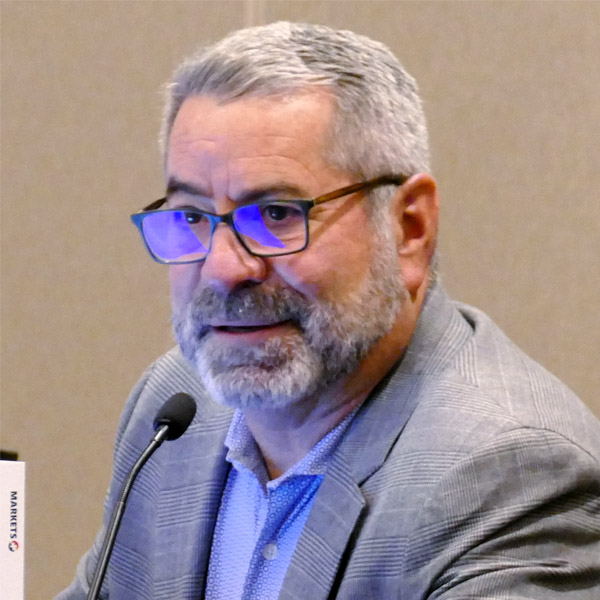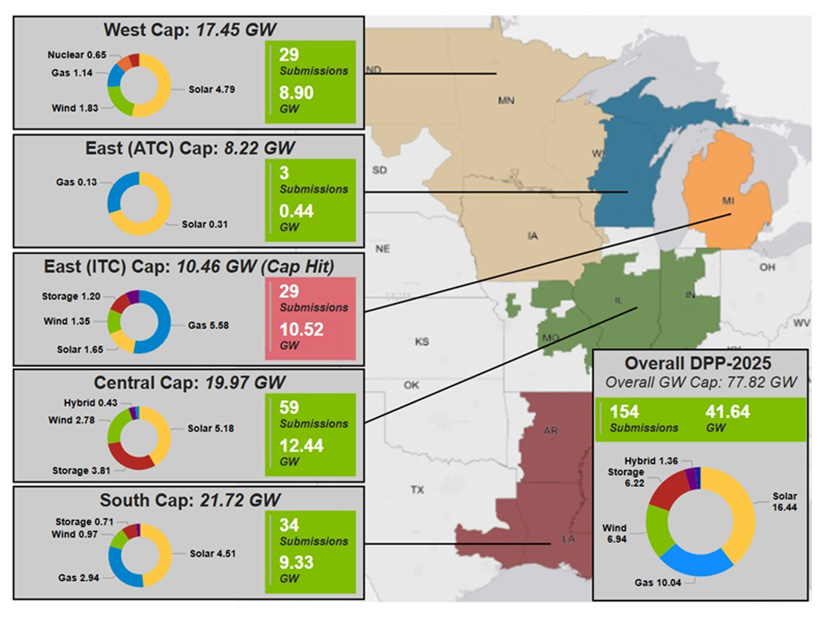DENVER — FERC’s approval of SPP’s Markets+ funding agreement and its recovery mechanism came as interested participants in the Western centralized day-ahead market were meeting with the snow-capped Rockies as a backdrop.
They cheered when they were notified of FERC’s decision during their April 22 Markets+ Participant Executive Committee (MPEC) meeting. Then they went back to work. (See FERC Approves SPP’s Funding Plans for Markets+.)
“We’re in go time,” MPEC Chair Laura Trolese, with The Energy Authority, told RTO Insider.
“Getting the FERC approval was super exciting. We got FERC approval both on the Markets+ funding agreement but also the final order on the last items last week,” she said, alluding to the commission’s April 17 approval of SPP’s final compliance filing for Markets+. (See FERC OKs Final SPP Markets+ Compliance Filing.)
“We needed those two things to move forward with implementation activities and timeline,” Trolese added.
Joe Taylor, with Xcel Energy subsidiary Public Service Company of Colorado (PSCo), said his company was pleased with the approval, which he said was not unexpected. PSCo filed a request in February with the Colorado Public Utilities Commission to join Markets+ and recover costs from its funding agreement. (See PSCo Seeks to Join SPP’s Markets+.)
“We made our filing assuming that [SPP’s request] was going to be approved, and it was,” Taylor said. “It was an expectation that the funding agreement would be approved, because then we can go forward and participate and execute that agreement.”
SPP’s Carrie Simpson, who broke the news to MPEC, recognizes that Markets+ development faces a long and winding road ahead.
“It’s just another important milestone. We’re grateful for it, and it will set us up for Phase 2,” she told RTO Insider.
FERC issued two orders in approving SPP’s proposed funding mechanism:
-
- The first accepted SPP’s proposed $150 million Phase 2 funding agreement as a rate schedule under the Markets+ tariff, effective March 24 (ER25-1372).
- The second granted SPP’s request to issue debt securities to cover the agreement and fund the market’s implementation over three years until its go-live date, effective April 21 (ES25-33).
SPP has set the go-live date as Oct. 1, 2027.
In its Feb. 21 filings, the grid operator told FERC the funding agreement will ensure those participants that benefit from the market will fund its development and share in overhead costs.
SPP said the funding agreement is a freely negotiated contract between the RTO and each of the eight entities that have agreed to participate in Phase 2 and provide collateral to SPP’s lender equal to the amount of their obligations: Arizona Public Service, Bonneville Power Administration, Chelan County (Wash.) Public Utility District (PUD), City of Tacoma, Grant County (Wash.) PUD, Powerex, Salt River Project and Tucson Electric Power.
The funding agreement requires the entities to provide the collateral backstop to SPP’s lender in supporting the financing the RTO will use to develop Markets+’ systems, processes and operations during implementation. The collateral is equal to the amount of the entities’ Phase 2 obligations.
SPP says the cost to repay the financing will be incorporated into Markets+ rates and will relieve participants from the burden of providing “large sums of money to directly fund Phase 2.” SPP is splitting the phase into two stages, with participants required at first to provide collateral equal to two-thirds of their Phase 2 obligation. The first stage expires six months after the initial funding threshold has been met, at which point participants must provide collateral equal to their full Phase 2 obligation.
As a federal agency, BPA — the major industry player in the Pacific Northwest — can’t post collateral to back up its commitment. BPA instead will provide a letter of assurances from its COO that explains its authority to enter into the agreement and statutory obligation to pay part or all of its Phase 2 obligation, whichever is effective at the time.
5 Steps of Funding
The funding agreement is composed of five stages:
-
- When the funding threshold is met by entities that are or represent at least two contiguous balancing authorities and not less than 200,000 GWh of 2023 net energy for load execute the funding agreement. That was met Feb. 13 when funding agreements first were signed. (See SPP Secures Funding to Begin Markets+ Phase 2.)
- When financing conditions are met with the financing’s regulatory approval and when SPP executes the loan agreement.
- When participants provide collateral to back financing determined by their Phase 2 obligation in the form of cash or a letter of credit. The obligation is the participant’s pro rata share of Markets+’s total cost less its Phase 1 and post-Phase 1 payments. (Funding participants withdrawing from the agreement must pay their Phase 2 obligation to SPP, protecting the remaining participants from the withdrawal.)
- When SPP obtains funds drawn from the loan or received under the funding agreement to acquire, create and/or modify the systems and processes required to implement Markets+.
- When financing costs are repaid after go-live. Phase 2’s implementation costs will be incorporated into market rates charged to participants through a tariff schedule. SPP will repay the financing as the costs are recovered and the lender authorizes the release of excess collateral on an annual basis. The funding agreement will terminate when SPP notifies participants that the financing has been fully repaid, including all principal, interest and fees.
FERC found the funding agreement will provide a framework for SPP to begin the market’s development phase. It said the funding participants’ provision of collateral and Phase 2 cost-recovery ensures that only Markets+ beneficiaries — and not SPP RTO members — are responsible for the development costs.
The commission declined to direct SPP to provide a commitment that its RTO members will not be responsible for the financing costs. “SPP has already provided sufficient commitment that this will be the case,” FERC said.
“In addition, the funding agreement itself does not implicate SPP RTO members in the event of a default or withdrawal of a funding participant,” the commission added.
FERC rejected several concerns raised by public interest organizations (PIOs) around BPA’s connection to the agreement. The groups, which include Northwest Energy Coalition, Idaho Conservation League and Public Citizen, said the agreement effectively would obligate Bonneville to participate in Markets+ ahead of issuing its formal record of its participation decision (ROD) on its day-ahead market participation because it would be on the hook for providing up to $40 million in implementation costs to SPP even before releasing the ROD. They contended that either SPP’s filing had mischaracterized BPA’s commitment to Markets+ or the agency had been engaging in a “sham” process regarding its day-ahead market decision.
“We disagree with PIOs that the funding agreement requires Bonneville (or any other funding participants) to participate in Markets+,” FERC wrote. “As PIOs acknowledge, the funding agreement requires a funding participant to pay its Phase 2 obligations in the event it decides to withdraw from the funding agreement; however, the funding agreement does not obligate any funding participant to proceed with Markets+ participation.”
The commission found in its second order that while SPP didn’t meet FERC’s interest-coverage ratio threshold, the grid operator cited other factors that gave it a “sufficient alternative basis” to determine the RTO had “reasonable prospects for being able to service the proposed new debt securities.” FERC said the Markets+ tariff, approved this year, will provide for the recovery of all of the proposed indebtedness’ financing costs.
“Furthermore, we note that SPP has secured commitments from the funding participants, which guarantees that SPP will be able to repay its debt obligations related to Markets+,” the commission wrote. It added that SPP’s plans to recover the implementation’s costs will not make its RTO members responsible for the market’s costs.
FERC set the loan’s interest rate not to exceed the total of a one-month secured overnight funding rate and a spread determined by the amount of cash collateral obtained from the funding participants.

